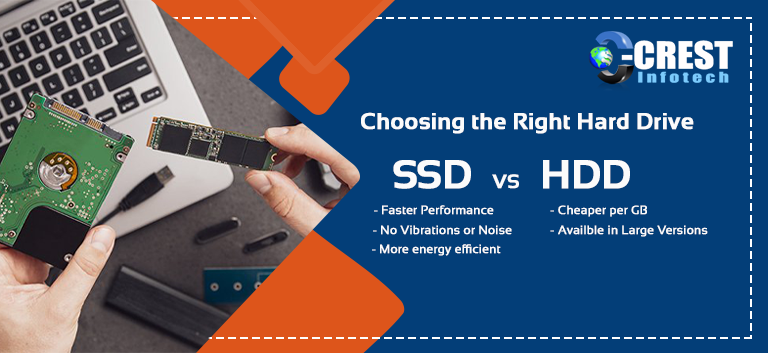SSD or HDD: which is better?
The question of “which is better hard drive: HDD or SSD?” is as important as it is common, whether you’re looking for additional storage, replacing a current hard drive, or buying a new computer and need help with specifics.
It’s not going to be as simple as tossing a coin to decide between HDD and SSD. It’s just the beginning when it comes to considering use, importance, expense, and scale. In this in-depth guide, we’ll teach you everything you need to know about hard drives and how to choose the right one.
What is a Hard Disk Drive (HDD)?
Hard disc drives (HDDs) have been available for more than five decades and are known as the “classic” hard drive. A hard disc drive is a record player if a solid state drive is a digital media player. Given that hard disc drives use spinning discs (called platters) and must read and write data, this is an appropriate analogy.
Hard disc drives have expanded storage capacity while shrinking in physical size as technology has advanced. They’re still an important part of the tech ecosystem. That’s because hard drives hold everything from your operating system and installed programmes to your files, directories, and other data.
What is a Solid State Drive (SSD)?
Solid State Drives (SSDs) have been around for a long time, even though they are considered a newer storage technology. You might not have realised it. Can you recall storing and moving data on thumb drives or flash drives? Consider those your first encounters with a solid-state drive.
In contrast to the “record player” hard disc drive, a solid state drive has no moving parts. Solid-state drives, on the other hand, use Negative-AND (NAND) flash memory. The greater the number of NAND memory chips, the greater the storage space.
NAND flash memory is a form of non-volatile memory that reads and writes data to a hard drive. It does not require power to save data; instead, it saves data in blocks and stores it using electric circuits. However, NAND has a limited number of write cycles, resulting in performance degradation over time. So, despite the fact that your solid state drive is physically more durable than a hard disc drive (shock resistance, ability to withstand extreme temperatures, and water immersion), it will inevitably fail. We’ll go into that in greater depth later in this post.
What is a Solid State Drive (SSD)?
Solid State Drives (SSDs) have been around for a long time, even though they are considered a newer storage technology. You might not have realised it. Can you recall storing and moving data on thumb drives or flash drives? Consider those your first encounters with a solid-state drive.
In contrast to the “record player” hard disc drive, a solid state drive has no moving parts. Solid-state drives, on the other hand, use Negative-AND (NAND) flash memory. The greater the number of NAND memory chips, the greater the storage space.
NAND flash memory is a form of non-volatile memory that reads and writes data to a hard drive. It does not require power to save data; instead, it saves data in blocks and stores it using electric circuits. However, NAND has a limited number of write cycles, resulting in performance degradation over time. So, despite the fact that your solid state drive is physically more durable than a hard disc drive (shock resistance, ability to withstand extreme temperatures, and water immersion), it will inevitably fail. We’ll go into that in greater depth later in this post.
What are the best use cases for SSD and HDD in terms of storage and speed?
Mass storage is the perfect use for a hard disc drive. If you need to store years of company data and resources or backups of all eight seasons of Game of Thrones, hard disc drives provide a lot of storage for a lot less money than solid state drives. You can easily get one or more HDDs greater than 1TB for a fraction of the price of their SSD counterparts. The good news is that most PC cases have room for several hard drives, allowing you to stack as much storage as you want (for two backups of Game of Thrones, for example).
The best application for an SSD is for pace. Consider this not only in terms of information processing, but also in terms of writing. Do you want to wait for minutes for high-resolution images or 4K videos to load before making edits? You don’t, of course. The time it takes to load and write such files is cut in half with SSDs.
SATA III ports are found on many SSDs, allowing them to be easily mounted in place of or in addition to an HDD. SATA allows the SDD to handle data four to five times faster than an HDD (read/write speeds of about 550 MB/s).



